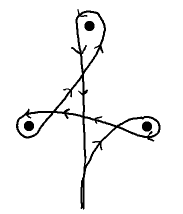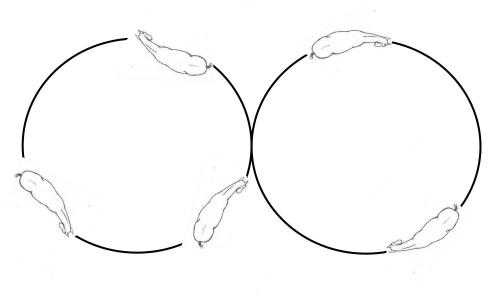Barrel Racing 101: Understanding the barrel pattern and the perfect circle
Barrel racing, like other equine disciplines, requires proper preparation and practice to succeed.

Barrel racing can be fun, rewarding and exciting for 4-H riders and their horses! But running a perfect pattern, with a fast time, takes patience, practice, preparation and skill. To begin, riders should ensure their horses are properly equipped for barrel racing. Next, riders must lay the foundation for horses to learn the barrel pattern, which takes a lot of time and practice.
Slow work is an essential key in introducing your horse to the barrel and speed patterns, as well as maintaining them. A horse must be willing to perform various maneuvers at various speeds, including slower ones such as the walk or trot. Remember that a “hot” horse is not the best choice for a barrel racing horse; a mild-tempered, willing horse that has natural athletic ability is a good choice. This article will explain the barrel pattern and prepare you to ride the perfect circle.
Why are circles so important? Practicing circles helps you to create muscle memory in both you and your horse so when circling around the barrel at a high rate of speed, the horse has his body in the correct position to make a nice turn and the rider is able to maintain control over the horse.
The barrel pattern
 The barrel pattern is fairly simple; there are three barrels set up in a triangular pattern and each rider must turn each barrel in a clover leaf pattern as fast as they can. Riders may choose to run a pattern that requires one right hand turn and two left hand turns or vice versa. The diagram below illustrates a right handed pattern, which is where the rider chooses the barrel on the right to be their first barrel. They will then move in a straight line across the pen to barrel two, where they will make a left handed turn. From there, the rider will head straight to barrel three for another left hand turn before finally sending the horse back across the timer line.
The barrel pattern is fairly simple; there are three barrels set up in a triangular pattern and each rider must turn each barrel in a clover leaf pattern as fast as they can. Riders may choose to run a pattern that requires one right hand turn and two left hand turns or vice versa. The diagram below illustrates a right handed pattern, which is where the rider chooses the barrel on the right to be their first barrel. They will then move in a straight line across the pen to barrel two, where they will make a left handed turn. From there, the rider will head straight to barrel three for another left hand turn before finally sending the horse back across the timer line.
An important part in understanding the barrel pattern is recognizing it is a series of straight lines and quick, tight turns. Practicing coming out of each turn in position to head straight to the next barrel is going to shave time off your run.
Horse and rider preparation
 Before you even walk your horse around the barrel pattern, you and your horse must be able to do a perfect circle in the correct lead at a walk, trot and lope. A perfect circle does not just mean your horse can lope around in a circle; it means your horse’s body position throughout the circle is correct and your horse is collected. To be in the correct body position, the horse’s nose is slightly tilted in to the inside of the circle, his shoulders are free and able to naturally move through the circle, his rib cage is slightly bent to the inside, and his hip is underneath him. This is the position you want your horse to be in as he is going around the barrels.
Before you even walk your horse around the barrel pattern, you and your horse must be able to do a perfect circle in the correct lead at a walk, trot and lope. A perfect circle does not just mean your horse can lope around in a circle; it means your horse’s body position throughout the circle is correct and your horse is collected. To be in the correct body position, the horse’s nose is slightly tilted in to the inside of the circle, his shoulders are free and able to naturally move through the circle, his rib cage is slightly bent to the inside, and his hip is underneath him. This is the position you want your horse to be in as he is going around the barrels.
When practicing your circles in both directions, move your horse into smaller circles and out to bigger circles. This helps riders maintain and gain control over each of the horse’s body parts. Circles are also a good way to warm your horse up before a workout.
 More advanced horses and riders may want to add counter-bending to their circles. Counter-bending is a great way to free up your horse’s shoulders and continue to gain control over each separate body part. To counter-bend, start your horse off in a regular circle, making sure your horse is relaxed and at ease. Next, ask your horse to only move his nose and rib cage away from the inside of the circle, while maintaining the correct circle position in his shoulders and hind quarters. Only hold this position for a stride or two before returning back to the original circle body position.
More advanced horses and riders may want to add counter-bending to their circles. Counter-bending is a great way to free up your horse’s shoulders and continue to gain control over each separate body part. To counter-bend, start your horse off in a regular circle, making sure your horse is relaxed and at ease. Next, ask your horse to only move his nose and rib cage away from the inside of the circle, while maintaining the correct circle position in his shoulders and hind quarters. Only hold this position for a stride or two before returning back to the original circle body position.
Stay tuned for more Michigan State University Extension articles on barrel racing, including slow work drills for your speed horse!



 Print
Print Email
Email





